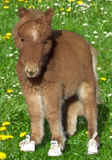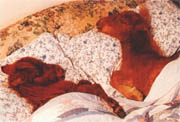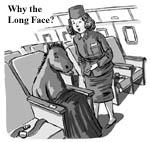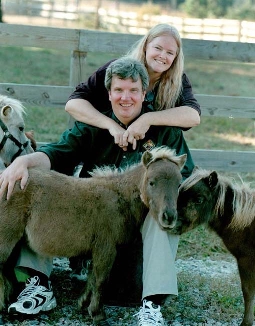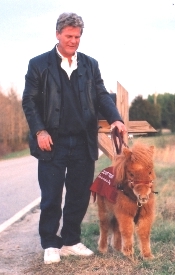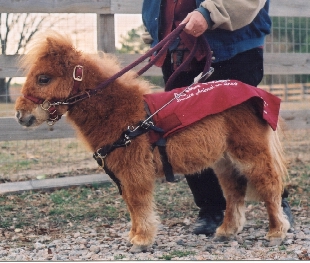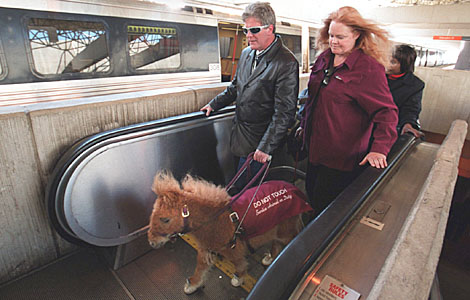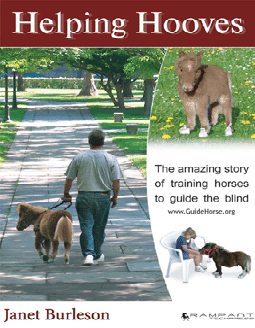|
|
Twinkie, The Guide Horse By Carolyn Wills Miniature Horse World, June/July 2000 It takes a fairly extraordinary subject to be featured on WTBS’ "Ripley’s Believe It Or Not". To most viewers on the evening of March 22, the story of "Twinkie, The Guide Horse" must have been an experience in "seeing is believing". For featured guests, Janet and Don Burleson, it was yet another step in the development of a revolutionary idea: the miniature horse as a guide for the visually impaired. Janet Burleson has been involved with horses for over 35 years. "Horses have been guiding people for centuries," she says. "From wounded soldiers in battle to drunken farmers in wagons, horses have been trusted to know the way home. With patience and training, they are also wonderfully adaptable. Look at the police or military mounts who are willing to perform in the most extreme situations." About ten years ago, Janet took a break from professional horse training to become a full-time web-site designer; and two years ago, she married Don Burleson, a computer specialist and author of software books. Shortly after they married, the Burleson’s bought their first Miniature horse, an AMHA registered thirty-inch stallion, named "J&Ks Smokey". Today, the couple lives on a 13-acre farm outside of Raleigh, North Carolina, with six Miniatures and six Arabian horses. And, they are responsible for the idea and testing of a Miniature horse as a "Guide Horse". The Burleson’s idea to launch their Guide Horse experiment evolved from a series of circumstances. Don’s high-tech profession often calls for trips to Manhattan, and when he and Janet travel together, they frequently go horseback riding in Central Park. To get from the rental stable to Central Park is a rather significant ride through the city. Early on, Janet and Don were impressed with the "city" horses and how well they adapted to their busy environment. On the New York streets, they were so calmly attuned to the sights and sounds around them; it was obvious the horses had learned traffic patterns, understood traffic lights, and knew the importance of stopping at intersections. Janet and Don, already considering ways in which horses might be used as service animals, were prompted by their Manhattan experience to explore to the idea of a "Guide Horse". "There is a history of relationships between horses and the visually impaired." Janet comments, "I knew of a blind rider who successfully showed in Hunter Pleasure. Her horse had learned to look out for her, to travel straight and to navigate the corners. There was such a bond between that horse and rider. Don and I also considered needs in other areas where horses would be useful, such as, helping to pull wheelchairs for the physically-challenged and assisting people who are able but have difficulty standing up." "But, what really led us to the development of the "Guide Horse" was the experience with our own Miniature horses. They are so naturally calm, so willing to bond with humans, and so accustomed to being in many different situations. And, their size and gait are so suitable for serving as guides. Of course these are generalities," Janet cautions, "and as is the case with all horse-related activities, it is important to select the individual animal with the best temperament and ability for the job he will be performing. The fact that we had such a candidate was crucial to our decision to move forward." For Janet and Don, Twinkie was an obvious choice for their first "Guide Horse". When Twinkie joined the Burleson’s family, she was already nine years old and while it makes sense to start guide-horse training with a young candidate, Twinkie is a remarkable exception. Raised as a pet, Twinkie is used to being in a house, riding in a car, and she’s small enough, has the perfect personality, and loves being a companion. When asked what she sees as the future for "Guide Horses", Janet stresses the fact that the idea is still in development. A Guide Horse has not actually been place with a visually impaired human. So far, Twinkie has performed well in her training. With a blind companion, she stops at stop-lights and does not "fidget"; walks the mall in special tennis shoes to avoid slipping; maintains a good steady pace; shares the street comer ramps instead of evading them and stepping to the curb, and comes to her companion when called. Janet and Don hope the Guide Horse idea continues to develop. They have another mare, who, like Twinkie, has an exceptional temperament. They hope other people will soon join in and pick up the Guide Horse training program and that, once developed, a Foundation is formed to support its future. "I believe this will be a gift for people who need the service of a guide animal," Janet says, "especially for those who may live in the country, have owned horses, or would love to have a relationship with a very special little horse."
|
Guides Training Press Photos News Apply FAQ Wishes Contact Home
|
|
Copyright © 1998 - 2005 by the Guide Horse Foundation Inc. Guide Horse ® Guidehorse ® and Helping Hooves ® are registered trademarks. |
The Guide Horse Foundation has the utmost respect for The Seeing Eye® and their seventy-two years of outstanding work with assistance animals for the blind. Even though the press often calls our horses "seeing eye horses", please note that The Guide Horse Foundation is not affiliated with or sanctioned by the Seeing-Eye® or any of the Guide Dog training organizations. Seeing-Eye® is a registered trademark of the Seeing-Eye, Inc.
